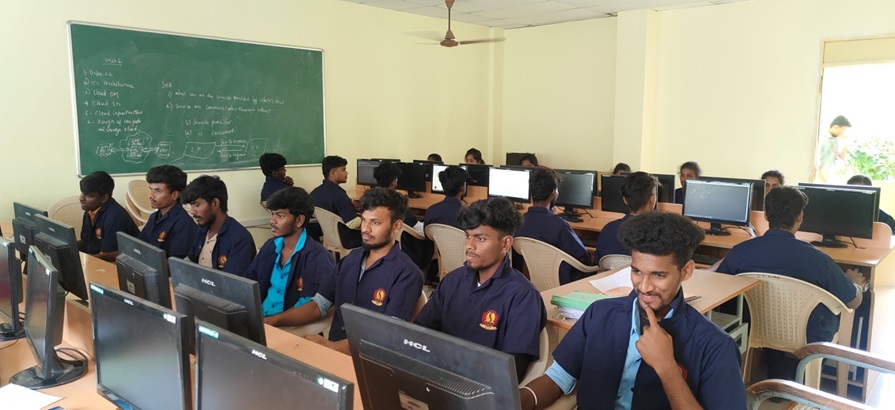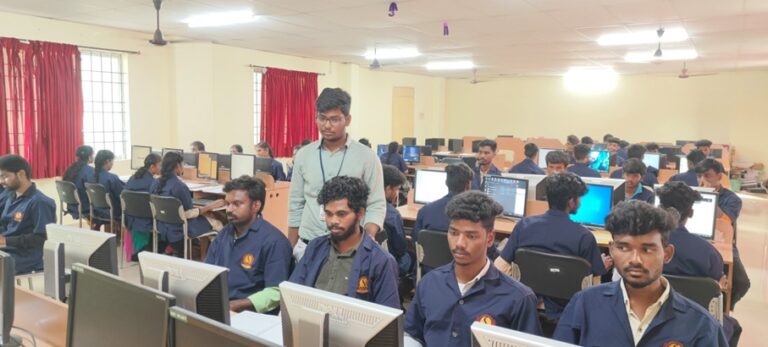AI & DS - FACILITIES
Laboratories
Laboratories
PROBLEM SOLVING AND PYTHON PROGRAMMING LABORATORY
Problem solving is a process. Most strategies provide steps that help you identify the problem and choose the best solution. There are two basic types of strategies: algorithmic and heuristic. Algorithmic strategies are traditional step-by-step guides to solving problems. Python is commonly used for developing websites and software, task automation, data analysis, and data visualisation. Since it’s relatively easy to learn, Python has been adopted by many non-programmers, such as accountants and scientists, for a variety of everyday tasks, like organising finances.

DATA STRUCTURES AND DESIGN LABORATORY
The Data Structure lab class intends to provide the students a practical knowledge of data structures so that the abstractions discussed in lecture classes are made concerete. A data structure is a specialized format for organizing, processing, retrieving and storing data. There are several basic and advanced types of data structures, all designed to arrange data to suit a specific purpose. Data structures make it easy for users to access and work with the data they need in appropriate ways.

DESIGN AND ANALYSIS OF ALGORITHAM
Algorithm analysis is the process of evaluating the performance of an algorithm, usually in terms of its time and space complexity. There are several ways to analyze the performance of an algorithm, including asymptotic analysis, which analyzes the behavior of an algorithm as the size of the input grows indefinitely. It covers the concepts of designing an algorithm as to solve various problems in computer science and information technology, and also analyse the complexity of these algorithms designed. The main aim of designing an algorithm is to provide a optimal solution for a problem.

DATA EXPLORATION AND VISULALISATION
Data exploration definition: Data exploration refers to the initial step in data analysis in which data analysts use data visualization and statistical techniques to describe dataset characterizations, such as size, quantity, and accuracy, in order to better understand the nature of the data. The main goal of data visualization is to make it easier to identify patterns, trends and outliers in large data sets. The term is often used interchangeably with others, including information graphics, information visualization and statistical graphics.

DATABASE DESIGN AND MANAGEMENT LABORATORY
The Database Lab Engine is an open-source experimentation platform for PostgreSQL databases. Instantly create full-size clones of your production database and use them to test your database migrations, optimize SQL, or deploy full-size staging apps. This lab is dedicated for students to work on practical experiments, projects and research work, related to courses such as Database Management Systems, Distributed Data Computing, Hadoop, Data Warehousing and Mining, and Big Data Analysis.

ARTIFICIAL INTELLIGENCE LABORATORY
The lab focuses on the recent advances in sub-areas of Artificial Intelligence and Machine Learning (AI and ML). The major thrust areas of current research include Image and Video Content Analysis, Computer Vision, Neural Architecture Search, Medical Image Computing, and Probabilistic Machine Learning. Integrating and reasoning with information from disparate data sources by training students, developers, data scientists, and researchers. Designing and implementing distributed systems for information exploitation, collaboration and decision making. IT has the ability to transform present diagnostic, disease preventive and control techniques, dramatically improving patient safety and treatment quality.

OPERATING SYSTEMS
This lab is used to study and implement the concepts of operating systems in detail. Along with the issues in operating systems such as resource management, Process scheduling and management, operating system design issues . To provide an understanding of the design aspects of operating system concepts through simulation. Introduce basic Unix commands, system call interface for process management, interprocess communication and I/O in Unix.

COMPUTER NETWORKS LABORATORY
The Computer Networks Laboratory (CNL) is the Institute’s center of research in computer networking and embedded computing applications. The lab is engaged in a wide range of projects, both practical and theoretical. The objective of this lab course is to get practical knowledge of working principles of various communication protocols. Analyse structure and formats of TCP/IP layer protocols using network tools such as Wireshark and network simulators. File sharing – you can easily share data between different users, or access it remotely if you keep it on other connected devices. Resource sharing – using network-connected peripheral devices like printers, scanners and copiers, or sharing software between multiple users, saves money.

DATA SCENCE AND ANALYTICS LABORATORY
A data lab is a designated data science system that is intended to uncover all that your data has to offer. As a space that facilitates data science and accelerates data experimentation, data labs uncover which questions businesses should ask, then help to find the answer. While the terms may be used interchangeably, data analytics is a subset of data science. Data science is an umbrella term for all aspects of data processing—from the collection to modeling to insights. On the other hand, data analytics is mainly concerned with statistics, mathematics, and statistical analysis.

MACHINE LEARNING LABORATOY
The ML Lab is a centralized hub for data science teams to seamlessly build, deploy, and operate machine learning solutions at scale. It is designed to cover the end-to-end machine learning lifecycle from data processing and experimentation to model training and deployment. It combines the libraries, languages, and tools data scientists love, with the infrastructure, services and workflows they need to deliver machine learning solutions into production. More information can be found below.

DEEP LEARNING LABORATORY
Laboratory learning is learning that takes place in a space where students can observe, practice, and experiment with objects, materials, phenomena, and ideas either individually or in groups. To identify innovative research directions in Artificial Intelligence, Machine Learning and Deep Learning. To provide quality education and practical skills to faculty and students in Deep Learning domain leading to quality publications and innovative models.

BIG DATA ANALYITICES
It is an interdisciplinary research laboratory, that focuses on large-scale data analytics problems that arise in different application domains and disciplines. Lab data analysis is the process of examining data that has been generated in a laboratory environment. The goal of this process is to generate valuable insights from these datasets which can subsequently be used to guide decision-making. Laboratory data are of two types. First one is an internal one which mainly deals with internal quality control and management. Second one is the lab output data, like analysis results or reports.

EMBEDDED SYSTEMS AND IoT
IoT embedded systems are the combination of physical objects and embedded systems technology that enable them to connect and communicate with each other and the internet. These systems consist of sensors, microcontrollers, and communication protocols that facilitate data collection, processing, and transmission. The Embedded Systems lab supports teaching and research in embedded systems and re-configurable hardware technology. We are engaged in research on architecture, design, and tools for networked and embedded computing and communication systems.

Software Specification
- Finger print image software
- Tally 9
- Rational Suit
- Dot Net
- Mobile tool Kit
- Java
- J2EE
- Windows Vista Business
- Windows XP
- Windows server
- Oracle Database 11GB
- Autocad
- Auto library Software









